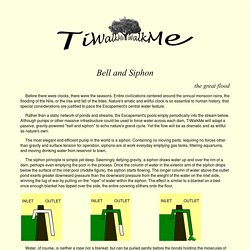

What makes a water feature sound good? I was refilling the pond in my garden (it got damaged by ice) and noticed the huge range of sounds that I could make.

Moving the hose around so the refilling water hit the rocks instead of the pond surface, changing the height of the hose or turn the water flow up or down, all created surprisingly large changes in sound quality. When setting up a water feature in a garden, or creating a fountain for a city square, you can make very different sounds by changing the design of the water flow. Water feature, Photo by Steve 2.0 A recent paper by scientists from Bradford University [1] have produced some new results about this.
They put people in a special acoustic test room and played lots of sounds of water features at them and got them to rate the quality of what they heard. References 1. Like this: Like Loading... Water clock. A display of two outflow water clocks from the Ancient Agora Museum in Athens.

The top is an original from the late 5th century BC. The bottom is a reconstruction of a clay original. A water clock or clepsydra (Greek κλέπτειν kleptein, 'to steal'; ὕδωρ hydor, 'water') is any timepiece in which time is measured by the regulated flow of liquid into (inflow type) or out from (outflow type) a vessel where the amount is then measured. Water clocks, along with sundials, are likely to be the oldest time-measuring instruments, with the only exceptions being the vertical gnomon and the day-counting tally stick.[1] Where and when they were first invented is not known, and given their great antiquity it may never be.
The bowl-shaped outflow is the simplest form of a water clock and is known to have existed in Babylon and in Egypt around the 16th century BC. Some modern timepieces are called "water clocks" but work differently from the ancient ones. Regional development[edit] Persia[edit] Egypt[edit] TiWalkMeBellAndSiphon. Before there were clocks, there were the seasons.

Entire civilizations centered around the annual monsoon rains, the flooding of the Nile, or the rise and fall of the tides. Nature's erratic and willful clock is so essential to human history, that special considerations are justified to pace the Escapement's central water feature. Rather than a static network of ponds and streams, the Escapement's pools empty periodically into the stream below. Although pumps or other massive infrastructure could be used to force water across each dam, TiWalkMe will adapt a passive, gravity-powered "bell and siphon" to echo nature's grand cycle. Yet the flow will be as dramatic and as willful as nature's own. Demonstrations. William D.

Jumper, Boris Stanchev, "Towards Explaining the Water Siphon", TPT, Vol. 52, # 8, Nov. 2014, p. 474. Alex Richert and P. Binder, "Siphons, Revisited", TPT, Vol. 49, # 2, Feb. 2011, p. 78. Ctesibius and the Tantalus Cup. While Ctesibius may not be as famous as Archimedes, Aristotle, and Pythagoras, he certainly deserves recognition as one of the world’s first and best engineers.

A prolific inventor living in the third century BC, Ctesibius is often referred to as “the father of pneumatics.” He created the first truly accurate water clock, a compressed-air catapult, a water pump, a musical organ that ran on water, and a number of remarkable machines that made use of siphons. At one time historians credited Ctesibius with inventing the siphon, but we now know it’s much older.
Around 1400 BC, during the reign of Pharaoh Amenhotep II, Egyptian engravers etched pictures on the walls of tombs at Thebes. One of these shows a group of aficionados siphoning wine from several containers into a large punch bowl, presumably to produce a blend of superior flavor and bouquet. But it was the classical Greeks, and Ctesibius in particular, who really explored the scientific principles by which siphons work. Backyard Aquaponics – Bell Siphon, The Magic of the System.
In my previous post about the aquaponics system I’ve built, I mentioned something called a “bell siphon”, and called it magic.

In truth it is simply science, but works so well and does so much with a very simple setup, that it may as well be called magic. What it does is allows water to fill up to its top, then drain the water down to the bottom of the stand by creating a self-starting siphon that allows self-terminates. As the growbed is continuously filled, the bell siphon allows the water to be intermittently dumped into the fish basin below.
This gives the plants both a period of water plus nutrients and a period of air for their root systems to allow optimal growth in the soil-less media. And since the bell siphon requires a pump to run continuously, no timer is needed, and the pump tends to have a longer life, since starting and stopping will shorten a motor’s life. Just kick it off and watch it go, just like this: